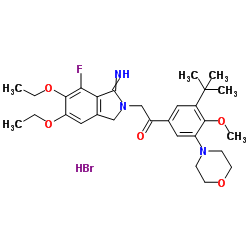Atopaxar hydrobromide
Modify Date: 2025-08-20 12:15:36

Atopaxar hydrobromide structure
|
Common Name | Atopaxar hydrobromide | ||
|---|---|---|---|---|
| CAS Number | 474550-69-1 | Molecular Weight | 608.539 | |
| Density | N/A | Boiling Point | N/A | |
| Molecular Formula | C29H39BrFN3O5 | Melting Point | N/A | |
| MSDS | N/A | Flash Point | N/A | |
Use of Atopaxar hydrobromideAtopaxar (E5555) hydrobromide is a potent, orally active, selective and reversible thrombin receptor protease-activated receptor-1 (PAR-1) antagonist. Atopaxar hydrobromide, an antiplatelet agent, interferes with platelet signaling. Atopaxar hydrobromide can be used for the research of atherothrombotic disease[1][2]. |
| Name | K3D2WJ7U0I |
|---|---|
| Synonym | More Synonyms |
| Description | Atopaxar (E5555) hydrobromide is a potent, orally active, selective and reversible thrombin receptor protease-activated receptor-1 (PAR-1) antagonist. Atopaxar hydrobromide, an antiplatelet agent, interferes with platelet signaling. Atopaxar hydrobromide can be used for the research of atherothrombotic disease[1][2]. |
|---|---|
| Related Catalog | |
| Target |
PAR-1[1] |
| In Vitro | Atopaxar hydrobromide (0.0001-10 μM; 1h) inhibits haTRAP (high-affinity thrombin receptor activating peptide) binding to PAR-1 on human platelet membranes in a concentration-dependent manner, with an IC50 of 0.019 μM[2]. Atopaxar hydrobromide inhibits human platelet aggregation induced by thrombin or TRAP in a concentration-dependent manner[2]. Atopaxar hydrobromide does not inhibit PRP (platelet-rich plasma) aggregation induced by ADP, U46619, collagen, and PAR-4ap, up to a concentration of 20 μM[2]. |
| In Vivo | Atopaxar (30-100 mg/kg; p.o.) hydrobromide causes a dose-dependent prolongation of the time to occlusion of the femoral artery in photochemically-induced thrombosis (PIT) guinea pigs model[2]. Atopaxar hydrobromide does not prolong bleeding time in guinea pigs at the highest tested dosage of 1000 mg/kg[2]. Animal Model: Guinea pigs, PIT model[2] Dosage: Oral administration Administration: 10 mg/kg, 30 mg/kg, 100 mg/kg Result: Prolonged the time to occlusion by 1.8-fold and 2.4-fold at 30 mg/kg and 100 mg/kg, respectively, compared with controls. |
| References |
| Molecular Formula | C29H39BrFN3O5 |
|---|---|
| Molecular Weight | 608.539 |
| Exact Mass | 607.205688 |
| Storage condition | -20°C |
| K3D2WJ7U0I |
| 2-(5,6-Diethoxy-7-fluoro-1-imino-1,3-dihydro-2H-isoindol-2-yl)-1-[4-methoxy-3-(2-methyl-2-propanyl)-5-(4-morpholinyl)phenyl]ethanone hydrobromide (1:1) |
| E 5555 hydrobromide |
| Ethanone, 2-(5,6-diethoxy-7-fluoro-1,3-dihydro-1-imino-2H-isoindol-2-yl)-1-[3-(1,1-dimethylethyl)-4-methoxy-5-(4-morpholinyl)phenyl]-, hydrobromide (1:1) |
| Atopaxar hydrobromide |
| MFCD25371545 |